Fortresses of North-West Russia
38 photo with description10.08.2020 12:46
10.08.2020 12:46
Andrey Panevin

A scattering of pearls of the North-West of Russia - preserved fortresses.
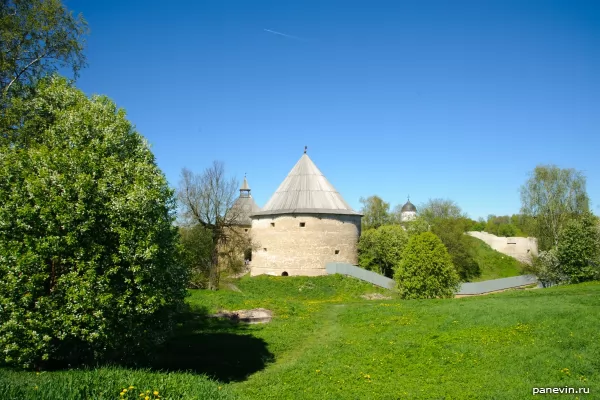
Old Ladoga Fortress, in the foreground - the Klimentovskaya Tower, behind it on the left - the Vorotnaya Tower.
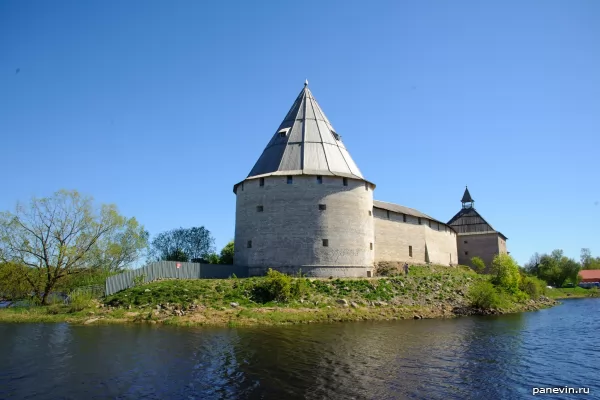
The arrow tower of the Staroladozhskaya fortress is located on the “arrow”, at the confluence of the Volkhov and Ladozhka rivers.
The history of the fortress is extensive, for example, in 997 it was destroyed by the Scandinavian Jarl Eirik. The fortress was again erected in 1114 by Pavel the mayor under Prince Mstislav. It should be noted that this was the first stone fortress of Ancient Rus. The appearance and spread of firearms in the XIV-XV centuries led to the need for a new restructuring of the fortress, 5 towers were being erected (Klimentovskaya, Vorotnaya, Tainichnaya, Strelochnaya and Raskatnaya). In 1585, for the first time in Russia, earthen ramparts were poured here.
During the turmoil of the 17th century and the Swedish expansion, the fortress passed from hand to hand several times, and only after the Stolbovsky Peace Treaty of 1617 finally ceded to Russia and becomes a frontier outpost.
At the beginning of the Northern War, Peter I increased the garrison of the fortress, but already in 1702, the capture of Noteburg pushed the border back by 100 km. Gradually, in connection with the construction of St. Petersburg, Kronstadt and the capture of Vyborg, the fortress loses its strategic importance and in 1714 from her garrison is withdrawn.
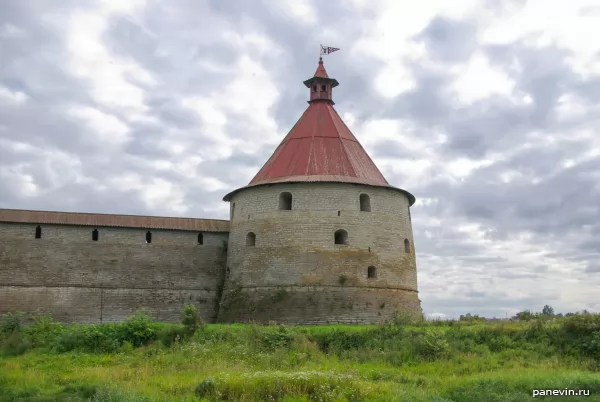
Golovin tower. From the 18th century to October Revolution 1917, the fortress served as a prison for dangerous political prisoners, in At various times, Tsarevna Sophia, Emperor John VI, Lenin's brother Alexander, Dzerzhinsky and so on were sitting here.
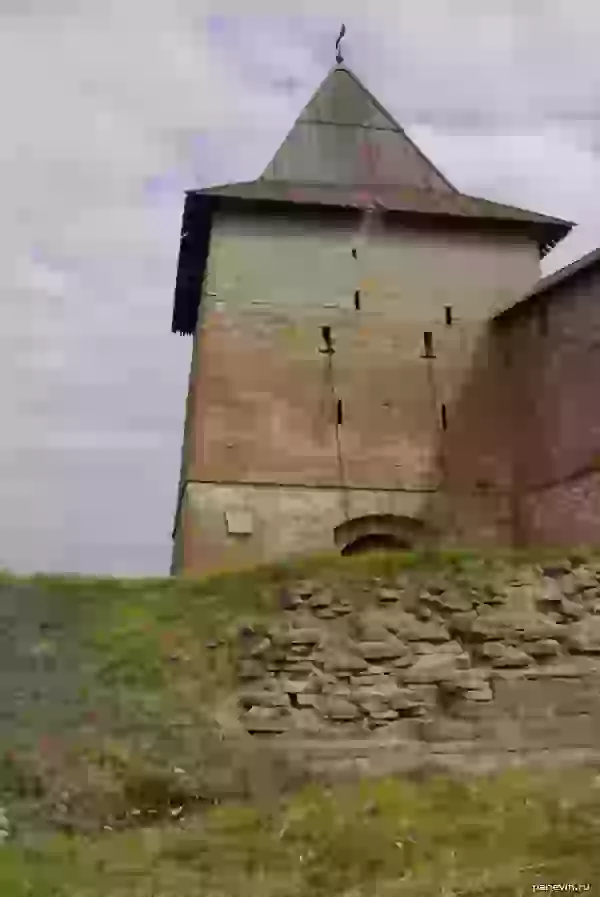
Gate Tower
The fortress was badly damaged during the Great Patriotic War. In 1941-1943, for 500 days, a small garrison of fighters of the 1st division of the NKVD troops and sailors of the 409th naval battery of the Baltic Fleet defended the fortress from German troops who were unable to cross to the right bank of the Neva and cut the Road of Life.
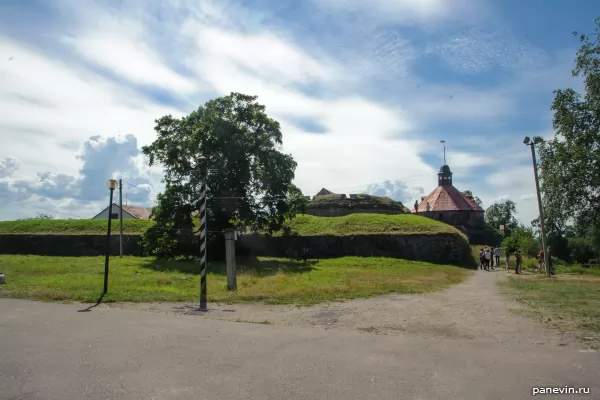
Fortress Museum "Korela" (Old Fortress).
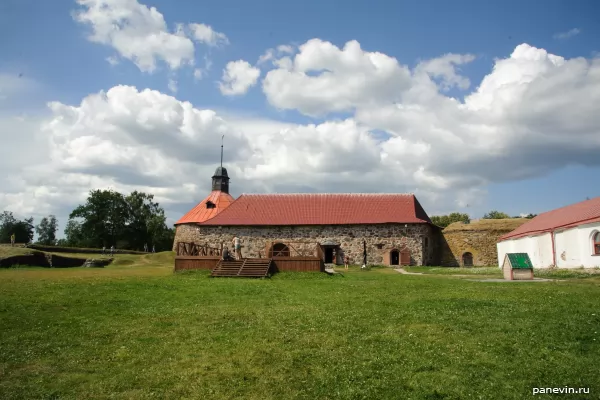
Old Arsenal, built in 1591, on the left behind it is the Round Gate Tower (Lars Torstensson Tower, Pugachevskaya Tower), built by the Swedes in 1585
In the 18th century, the border was pushed far to the west. hell, defensively the fortress lost its meaning and, like the Oreshek fortress, was used as a prison.
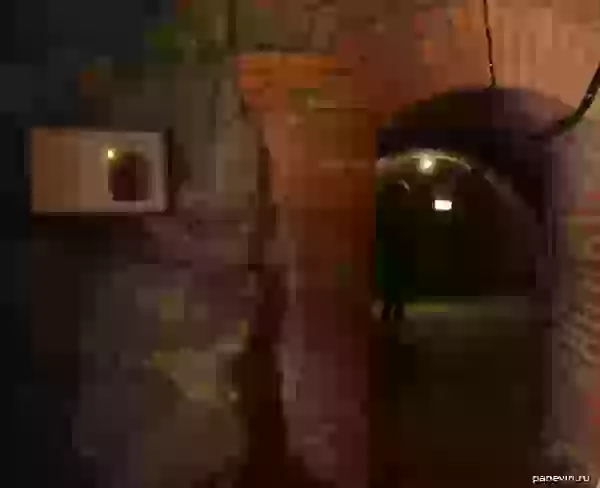
In September 1710, the Swedes were driven out of the city and Peter I personally ordered the wooden gates to be upholstered with captured Swedish armor. In 1994, the armor was transferred to the territory of the New Fortress at the request of the restorers.

The Pugachevs Camera. Since January 24, 1775, this room has housed the Pugachev family - the first wife Sofya Dmitrievna with three children, as well as the second wife “the Ural queen” Ustinya Petrovna Kuznetsova.
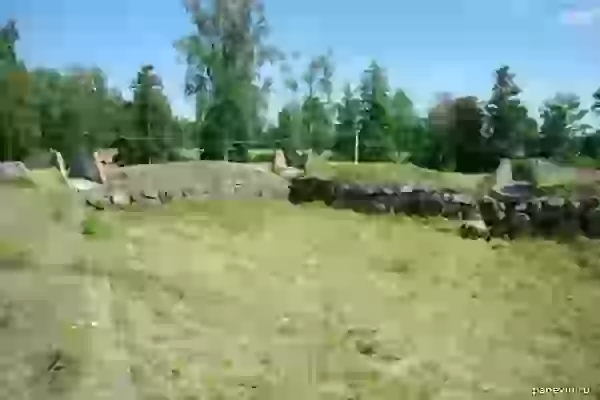
Bastion Bastion, there were guns in niches in the 18th century.
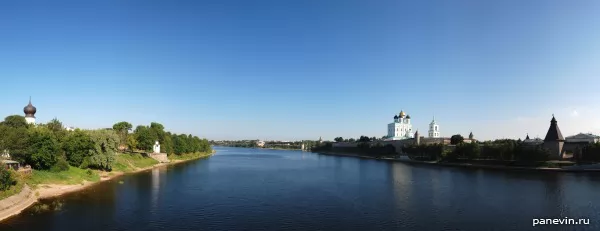
Panorama of the Velikaya River from the bridge. The newly built chapel in honor of Princess Olga (the founder of Pskov) offers a wonderful view across the Velikaya River to the Pskov Krom (Kremlin).
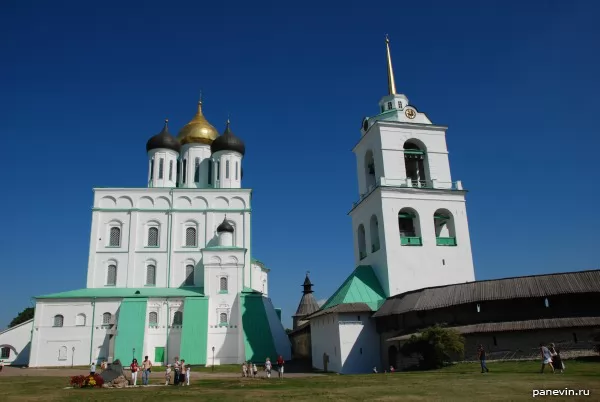
Trinity Cathedral Pskov Kremlin (1682-1699, the first cathedral was erected back in X century) was the main shrine not only of the city of Pskov, but of the entire Pskov land. For the people of Pskov, it was also important that the St. Sophia Cathedral was for the people of Novgorod.
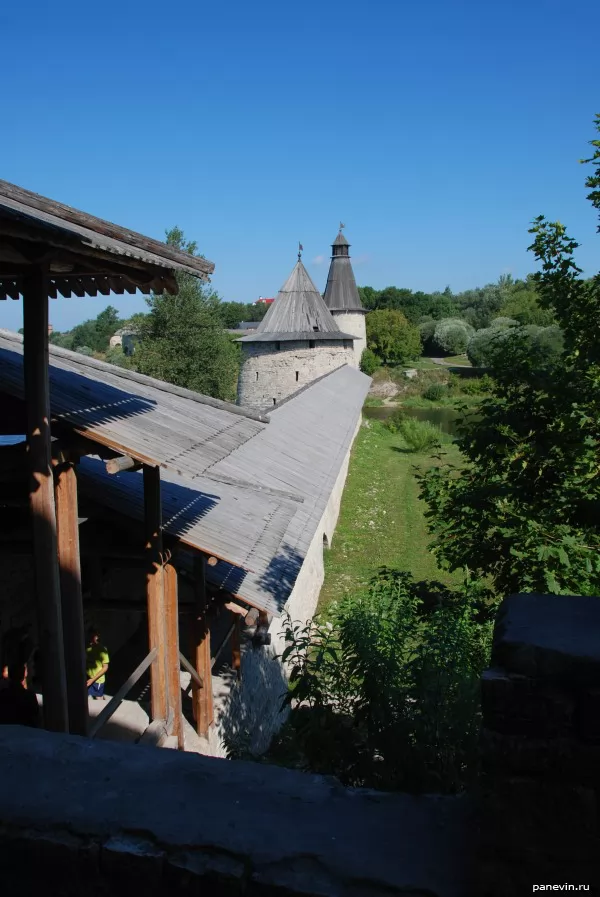
Lower lattice towers - Flat and High. The lower lattice towers are the common name for the defensive towers of Russian fortresses. Such towers were located on the banks of rivers above the streams that flowed into the fortress. During the siege, the streams were locked with bars, which is why such a name. Similarly, in the fortress Pskov-Pechersk Monastery there are towers of the Upper and Lower Lattices.
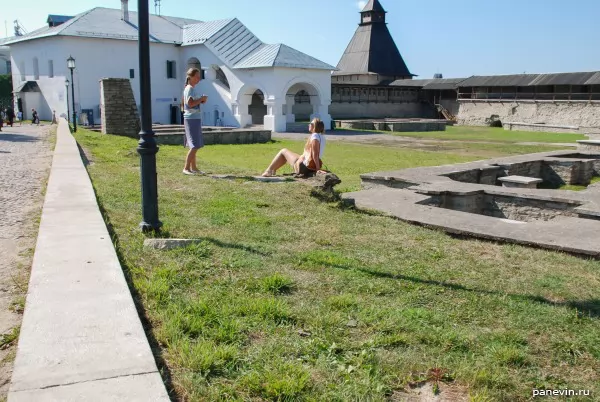
In the foreground on the right is the Dovmont town, the foundations of the oldest Pskov buildings. Behind - the Kremlin chambers.
The Pskov fortress was rightfully considered impregnable - the Kremlin citadel + defensive walls around Dovmont's city + external defensive structures around the posad (only fragments of the walls remained from the latter). The rivers Velikaya and Pskova provided additional natural protection.

Solovetskiy Kremlin
In 1596 the fortress became operational. Like many defensive structures of its time, the fortress responded to the latest achievements of the art of fortification. Its walls were designed for a perimeter defense, had a direct route and two tiers of battle. The towers strongly pushed forward made it possible to successfully conduct both frontal and flanking fire.
In the 16th-17th centuries, the monastery withstood several attacks by the Swedes (in 1571, 1582 and 1611). There were no attacks on the fortress until the middle of the 19th century. And in 1854, the commander of the English squadron demanded that the monks give all the cattle and valuables, but was sent to a well-known Russian address. The British, of course, were upset and staged a 9-hour continuous bombardment of the Solovetsky Obbodies. The almost unarmed fortress repelled the attack of the British squadron. 1,800 bombs and cannonballs were fired at the monastery. Summing up, the defenders were surprised by the complete absence of victims, “... death was on the hair from everyone, and - oh, a clear miracle! - at all times, not a single person was not only killed, but also not wounded, not even one of the gull chicks that were in the monastery yard was killed; to top it off, the core of the last enemy shot flew through the cathedral wall above the western gates, over the face of the icon of the Mother of God "The Sign", who deigned to take this wound for the monastery, like Her son for the whole world. After this shot, everything stopped, the next day the enemies withdrew in shame. According to the recall of the enemies themselves, from the number of shells thrown, not only a small, unarmed monastery, but six large cities could be destroyed, which they themselves realized by the obvious miraculous protection of God. "
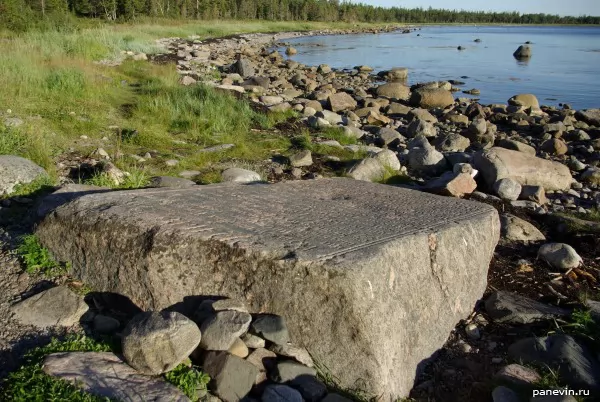
The negotiating stone at the place where on June 22 1854 negotiations were held between the rector of the Solovetsky monastery, Archimandrite Alexander, and an English officer.
Text on the Negotiation Stone of the Big Solovetsky Island:
The British, of course, were even more upset, they burned down the church on about. Anzer, having stolen from there a box with donations, set off to burn peaceful villages along the shores of the White Sea.
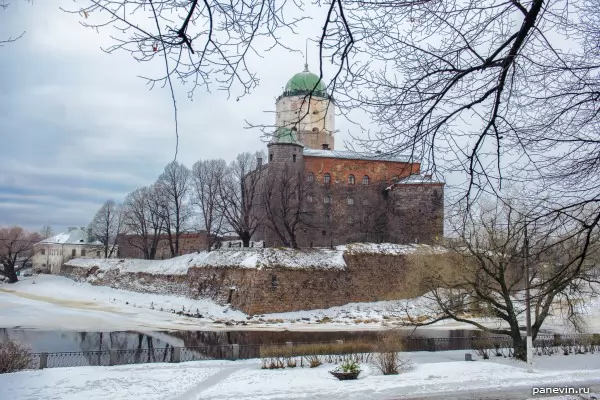
Vyborg Castle (Finnish Viipurin linna, Swede. Wiborgs slott) is the oldest of the Vyborg fortifications dating back to the 13th century, built on a small island (170 x 122 m) in the Gulf of Finland. The only fully preserved monument of Western European medieval military architecture in Russia.
Founded in 1293, it was seriously rebuilt twice (in the 16th century in order to adapt to the new conditions of warfare with the use of artillery, in the 1890s - after two devastating fires in the middle of the century). One can climb the highest tower of the fortress - Olaf's tower, from where a wonderful view of Vyborg opens.
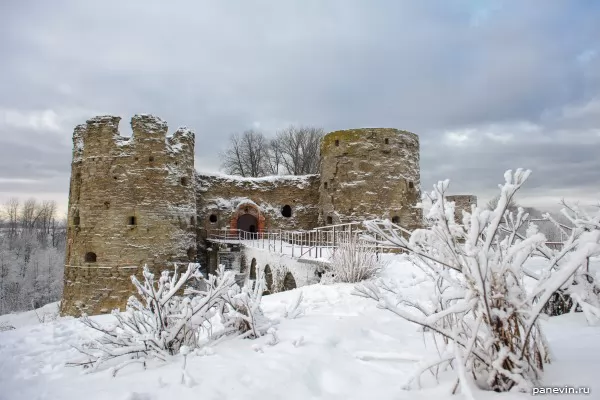
The gates of the Koporye fortress . Left - South Tower, right - North. The bridge was once a drawbridge.
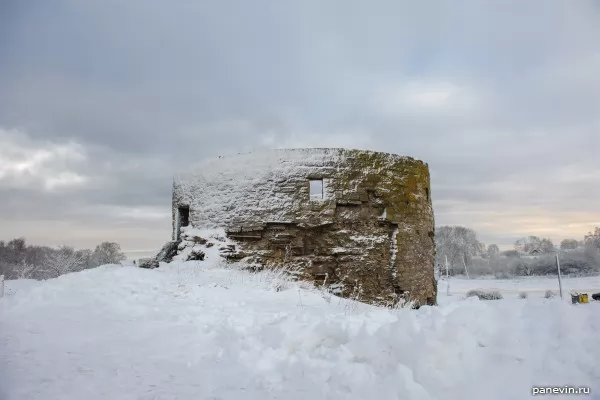
Middle Tower Koporskaya Fortress.
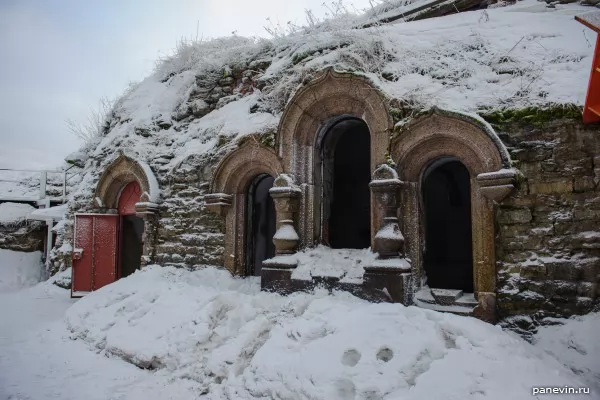
Fortress chapel - the family tomb of the Zinovievs.

The loopholes of the fortress
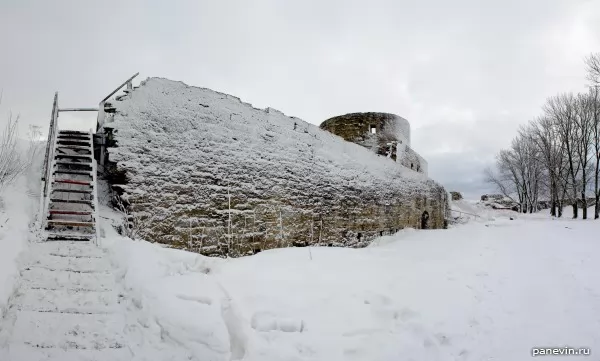
Fortress wall
The fortress in Koporye was founded in 1237. It was first mentioned in the Novgorod chronicles in 1240, when the German knights of the Livonian Order built a wooden fortress in the Koporsky churchyard.
In 1241, Alexander Nevsky captured the fortress from the German knights and destroyed it. The fortress was captured and destroyed several times, now by Novgorodians, now by the Swedes. She took part in both the Civil War and the Great Patriotic War.
One of the oldest Russian cities, Izborsk, is located 30 km from Pskov on the road to Riga. The first known settlement here was created by the Krivichs simultaneously with Smolensk and Polotsk. According to legend, the city was founded by Sloven Gostomyslovich (the first mayor of Novgorod) and named Slovensk, and later the son of Sloven, Izbor, renamed the city in his honor. Izborsk is first mentioned in the Tale of Bygone Years in connection with the legendary vocation of the Varangian princes to Russia (862).
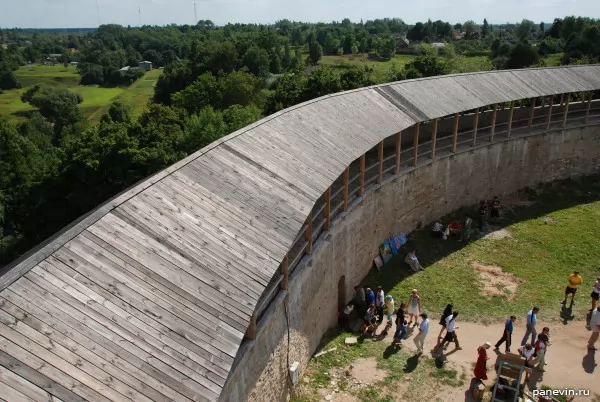
Fortress wall
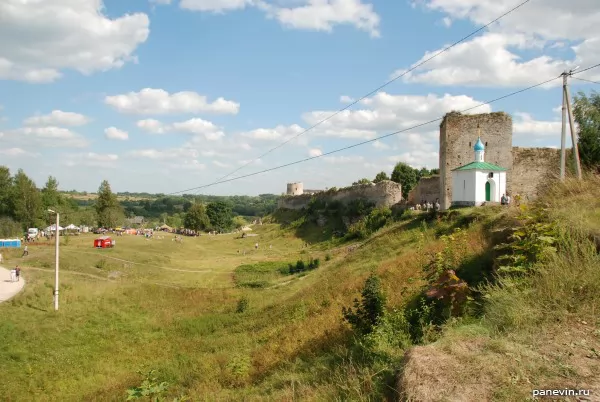
Fortress wall
The modern chapel and the Talava tower of the Izborsk fortress.
The fortress passed from hand to hand more than once - the Livonian Order, the Poles, the Pskov squads.
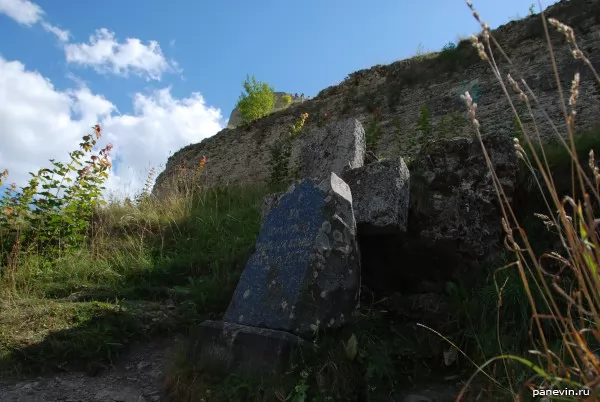
Ancient gravestones at the fortress wall of the Izborsk fortress.
The Smolensk fortress was built in 1595-1602 under the leadership of the architect Fyodor the horse (the author and the Moscow Kremlin).
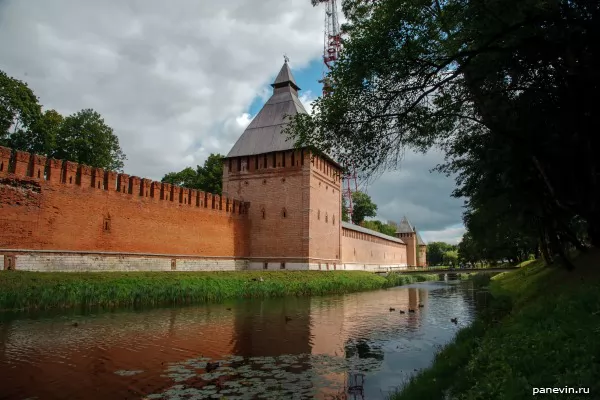
Kopitenskie Gates Smolensk fortress (Lopatinskiy Garden).
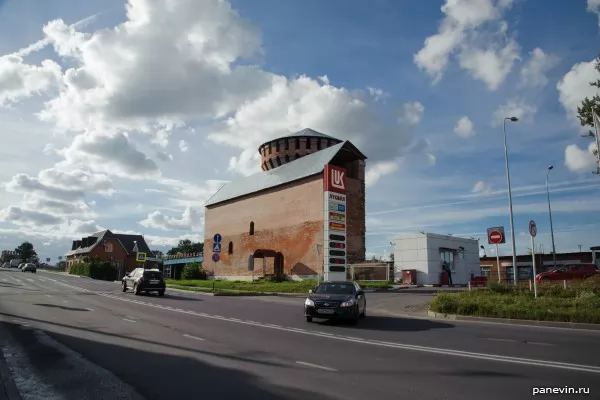
The Round Tower
The fortress wall of Smolensk is heavily fragmented, now from it there are still separate parts outlining the historic center. Round Tower, address: Smolensk, st. Sobolev, 14.
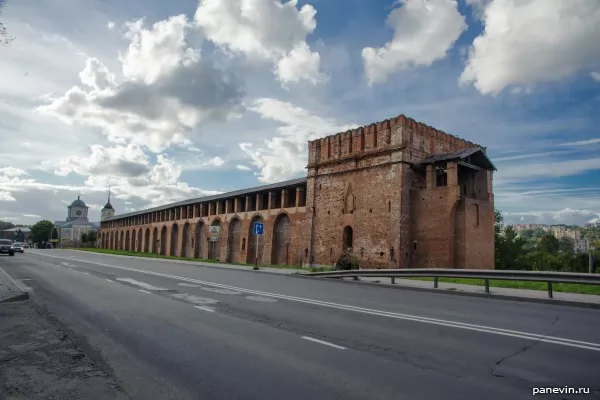
Volkov Tower Smolensk Kremlin, address: Smolensk, st. Sobolev.
The Smolensk Kremlin, the remains of a highly fragmented fortress wall in Smolensk, is a separate surviving part of the walls and towers that now encircle the historic city center. The fortress was badly damaged in the war of 1812, when most of the fortress was destroyed by the retreating troops of Emperor Napoleon I. The Great Patriotic Fortress also got it.
After the capture of the Swedish fortress Nyenskans, Peter I ordered to destroy it, and to lay a new one downstream of the Neva, closer to the Gulf of Finland.
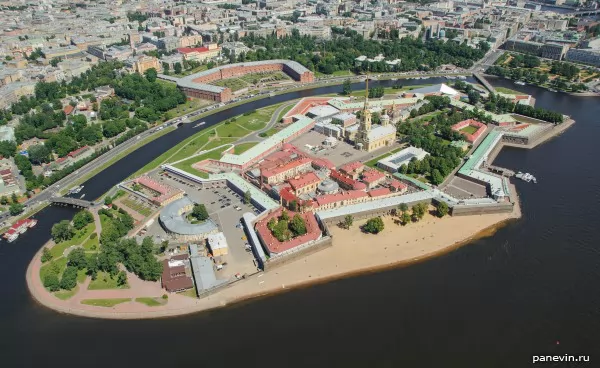
Zayachiy Island, Fortress St. Petersburg from the air.
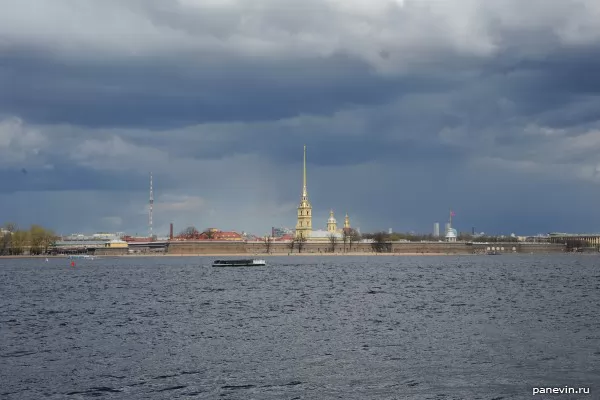
Fortress St. Petersburg
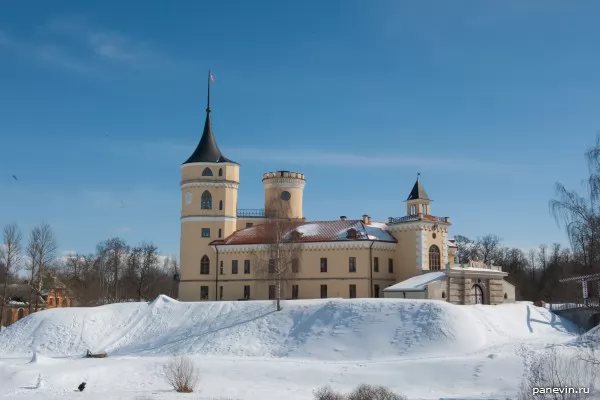
Bip Castle
An ancient castle of the late 18th century, similar to the medieval ones - the creation of the architect Vincenzo Brenna. During the years World War II it was completely destroyed by fire, only the walls remained. Castle "Bip" has been restored today, at the beginning of the XXI century. It is used as an "informal" meeting place for high-ranking officials of the city.
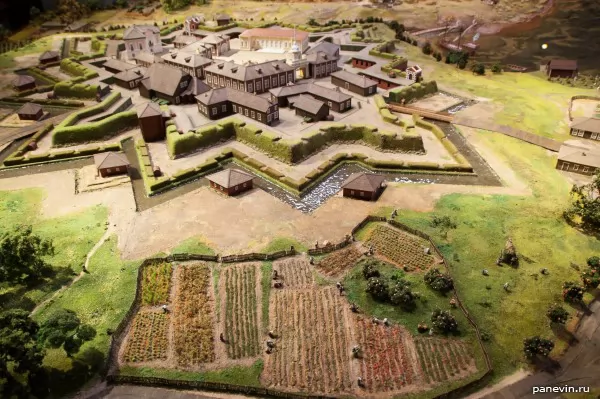
Fortress Petershtadt (layout). Now only the entrance gate and the palace of Peter III remain from the entire fortress.
Novgorod Detinets (Novgorod Kremlin) is located on the left bank of the Volkhov River. The first mention of it in chronicles dates back to 1044.
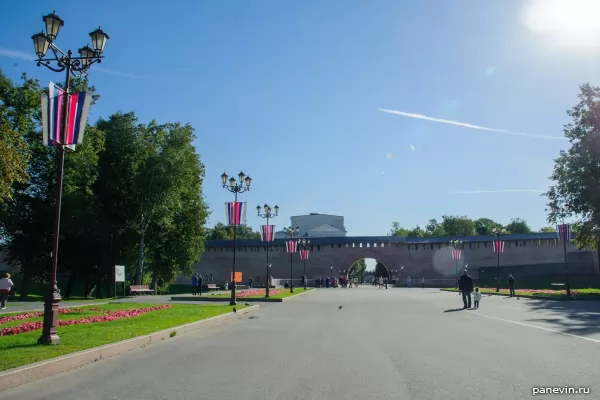
Alley to the fortress wall of the Novgorod Kremlin
Alley leading to the fortress wall Novgorod Kremlin, the bridge over the moat and the Resurrection arch (after the name of the once existing gate church).
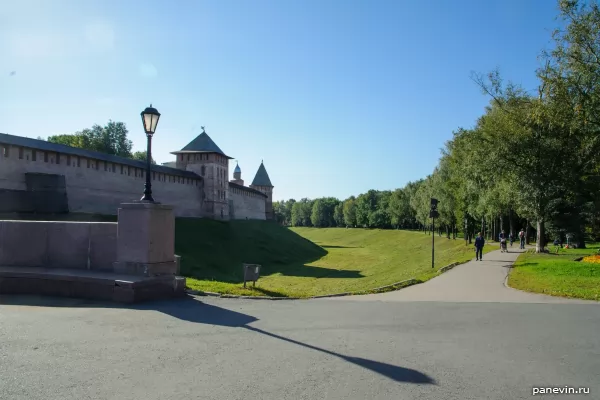
Fortress moat Novgorod Kremlin, on the left there is a fortress wall, the first tower is Zlatoustovskaya tower, the second - Pokrovskaya.
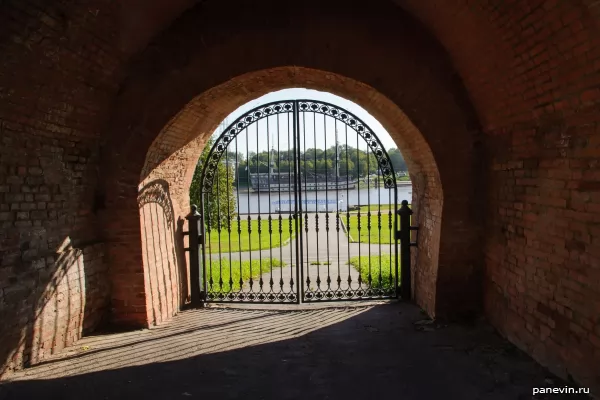
Secret water gates near Sofia belfry, view of the Volkhov and the Flagman restaurant (a la sailboat).
Secret water gates are a distinctive feature of the fortresses of Russia, through which merchants transferred goods to the fortress so that they could not learn the secrets of the fortress.
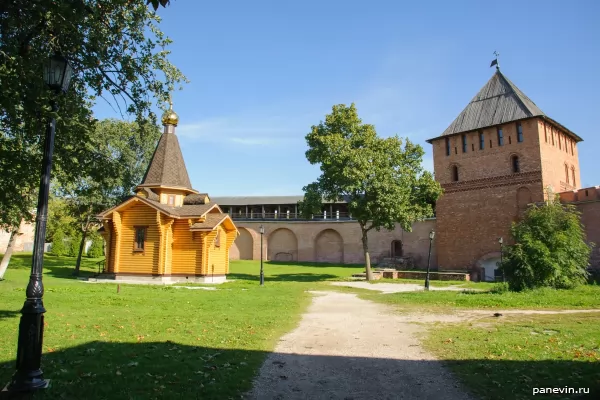
The Temple of the Equal-to-the-Apostles Prince Vladimir and the Vladimir Tower , Novgorod Kremlin.
A wooden one-domed church was built on this site as part of the celebration of the 1000th anniversary of the death of Prince Vladimir.
Vladimirskaya Tower - XV century.
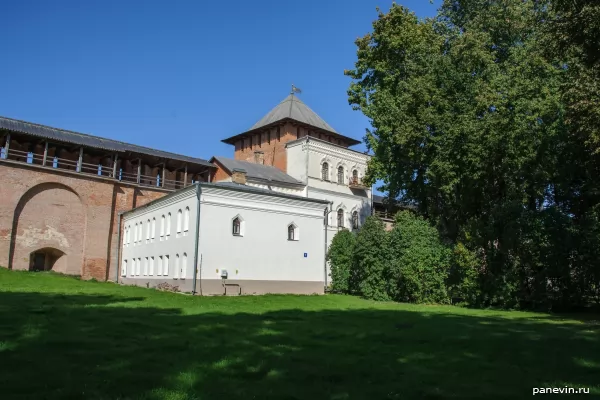
Museum of Antiquities (XIX century).
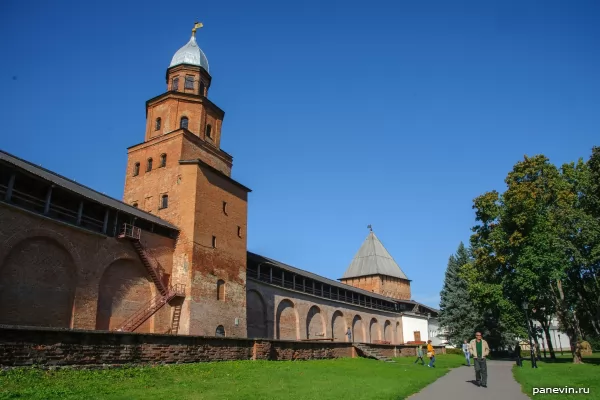
Kokuy Tower (Kukuy, Kalancha, Kalanchovskaya ) - a quadrangular blind (impassable) tower in the southwestern part of Novgorodsky Detinets, built according to the principle of "two eight over a quadruple". The tower is crowned with a silvered dome with the ensign of the Novgorod principality, above it a crown and a flower.
Badly damaged during the war, the tower was rebuilt in the 1960s to look like the 17th century.
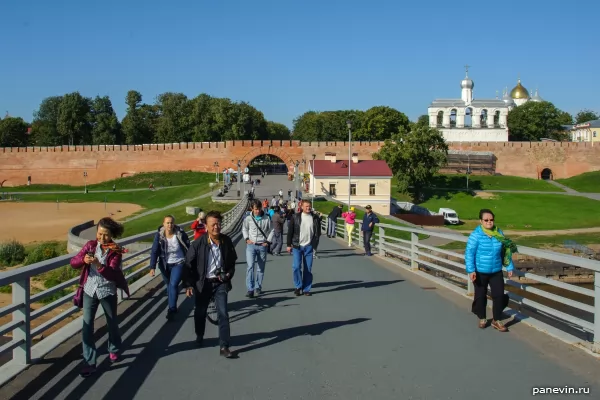
View of the Novgorod Kremlin from Gorbaty Bridge
View of Novgorod Kremlin and the Sofia Belfry from the Gorbaty Bridge.
In my collection of fortresses of the North-West, the only thing missing is the Gdov Fortress.
Staraya Ladoga Fortress
In the Leningrad region, not far from the city of Volkhov, there is the first capital of Russia - Staraya Ladoga, and in it, a well-preserved fortress. The first mention of the fortress dates back to 862 in the "Tale of Bygone Years", telling about the calling of Prince Rurik with the brothers Sineus and Truvor to Ladoga, she points to the construction of a wooden fortress by them. In the late 9th - early 10th centuries, the fortress was rebuilt in stone by Prophetic Oleg.
Old Ladoga Fortress, in the foreground - the Klimentovskaya Tower, behind it on the left - the Vorotnaya Tower.

The arrow tower of the Staroladozhskaya fortress is located on the “arrow”, at the confluence of the Volkhov and Ladozhka rivers.
The history of the fortress is extensive, for example, in 997 it was destroyed by the Scandinavian Jarl Eirik. The fortress was again erected in 1114 by Pavel the mayor under Prince Mstislav. It should be noted that this was the first stone fortress of Ancient Rus. The appearance and spread of firearms in the XIV-XV centuries led to the need for a new restructuring of the fortress, 5 towers were being erected (Klimentovskaya, Vorotnaya, Tainichnaya, Strelochnaya and Raskatnaya). In 1585, for the first time in Russia, earthen ramparts were poured here.
During the turmoil of the 17th century and the Swedish expansion, the fortress passed from hand to hand several times, and only after the Stolbovsky Peace Treaty of 1617 finally ceded to Russia and becomes a frontier outpost.
At the beginning of the Northern War, Peter I increased the garrison of the fortress, but already in 1702, the capture of Noteburg pushed the border back by 100 km. Gradually, in connection with the construction of St. Petersburg, Kronstadt and the capture of Vyborg, the fortress loses its strategic importance and in 1714 from her garrison is withdrawn.
Oreshek Fortress
Founded by the Novgorod prince Yuri Danilovich, the grandson of Alexander Nevsky, in 1323 on Orekhovy Island at the source of Neva, the fortress served as an outpost on the border with Sweden and reliably closed the exit from Neva river to Lake Ladoga.
Golovin tower. From the 18th century to October Revolution 1917, the fortress served as a prison for dangerous political prisoners, in At various times, Tsarevna Sophia, Emperor John VI, Lenin's brother Alexander, Dzerzhinsky and so on were sitting here.
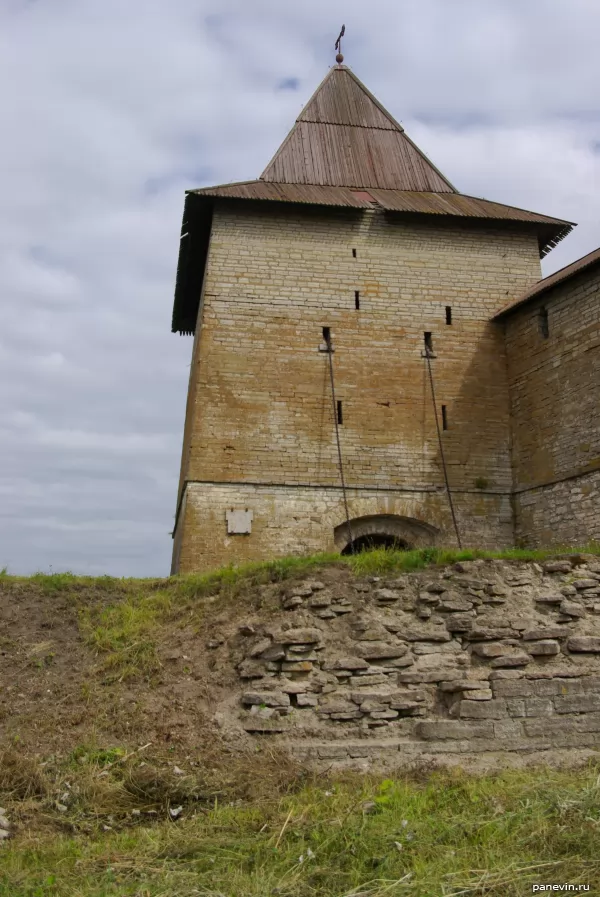
Gate Tower
The fortress was badly damaged during the Great Patriotic War. In 1941-1943, for 500 days, a small garrison of fighters of the 1st division of the NKVD troops and sailors of the 409th naval battery of the Baltic Fleet defended the fortress from German troops who were unable to cross to the right bank of the Neva and cut the Road of Life.
Fortress-Museum "Korela"
In the north of the Leningrad region is one of the most ancient cities of Russia - Priozersk, and its main attraction is the Korela fortress.
Fortress Museum "Korela" (Old Fortress).

Old Arsenal, built in 1591, on the left behind it is the Round Gate Tower (Lars Torstensson Tower, Pugachevskaya Tower), built by the Swedes in 1585
In the 18th century, the border was pushed far to the west. hell, defensively the fortress lost its meaning and, like the Oreshek fortress, was used as a prison.
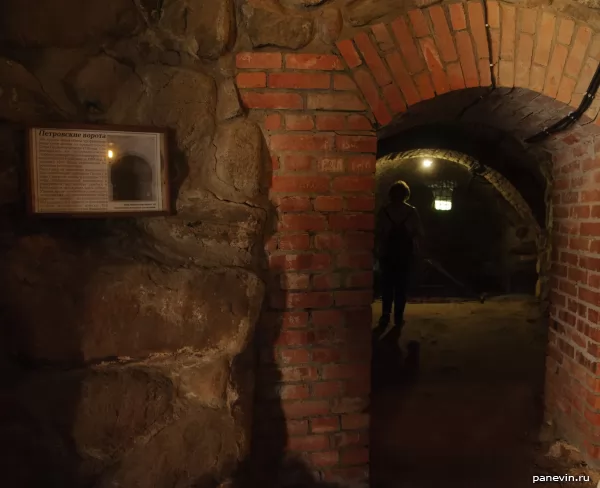
In September 1710, the Swedes were driven out of the city and Peter I personally ordered the wooden gates to be upholstered with captured Swedish armor. In 1994, the armor was transferred to the territory of the New Fortress at the request of the restorers.
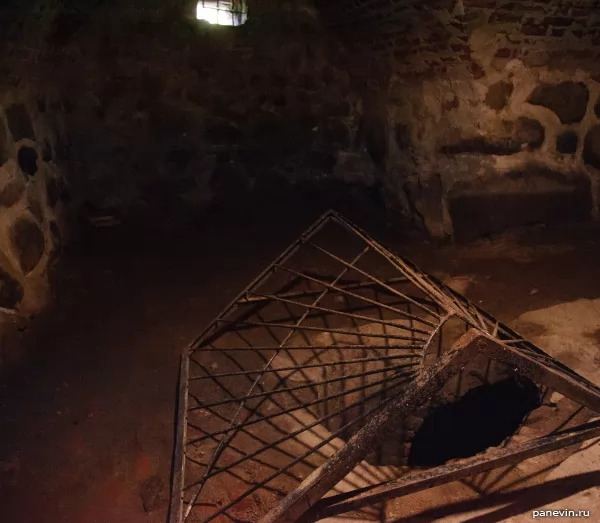
The Pugachevs Camera. Since January 24, 1775, this room has housed the Pugachev family - the first wife Sofya Dmitrievna with three children, as well as the second wife “the Ural queen” Ustinya Petrovna Kuznetsova.
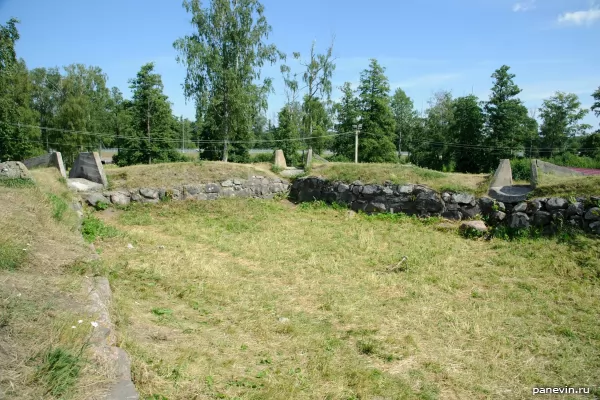
Bastion Bastion, there were guns in niches in the 18th century.
Pskov Kremlin (Krom)
In the late 11th - early 12th centuries, a fortress was built at the confluence of the Pskov and Velikaya rivers, which became one of the western outposts of Russia.
Panorama of the Velikaya River from the bridge. The newly built chapel in honor of Princess Olga (the founder of Pskov) offers a wonderful view across the Velikaya River to the Pskov Krom (Kremlin).

Trinity Cathedral Pskov Kremlin (1682-1699, the first cathedral was erected back in X century) was the main shrine not only of the city of Pskov, but of the entire Pskov land. For the people of Pskov, it was also important that the St. Sophia Cathedral was for the people of Novgorod.
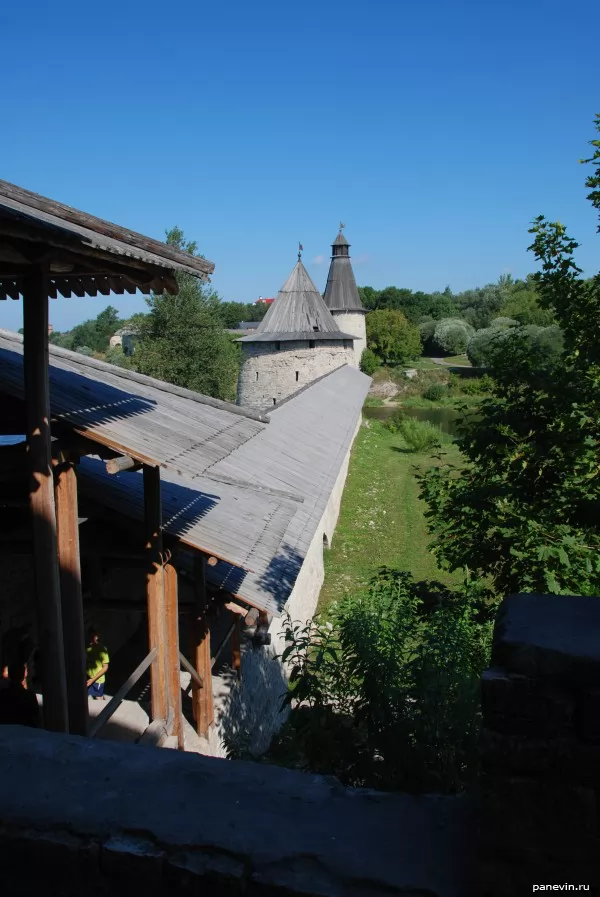
Lower lattice towers - Flat and High. The lower lattice towers are the common name for the defensive towers of Russian fortresses. Such towers were located on the banks of rivers above the streams that flowed into the fortress. During the siege, the streams were locked with bars, which is why such a name. Similarly, in the fortress Pskov-Pechersk Monastery there are towers of the Upper and Lower Lattices.
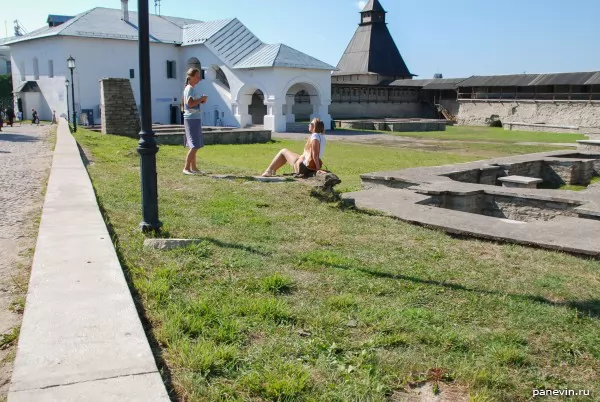
In the foreground on the right is the Dovmont town, the foundations of the oldest Pskov buildings. Behind - the Kremlin chambers.
The Pskov fortress was rightfully considered impregnable - the Kremlin citadel + defensive walls around Dovmont's city + external defensive structures around the posad (only fragments of the walls remained from the latter). The rivers Velikaya and Pskova provided additional natural protection.
Solovetsky Islands

Solovetskiy Kremlin
In 1596 the fortress became operational. Like many defensive structures of its time, the fortress responded to the latest achievements of the art of fortification. Its walls were designed for a perimeter defense, had a direct route and two tiers of battle. The towers strongly pushed forward made it possible to successfully conduct both frontal and flanking fire.
In the 16th-17th centuries, the monastery withstood several attacks by the Swedes (in 1571, 1582 and 1611). There were no attacks on the fortress until the middle of the 19th century. And in 1854, the commander of the English squadron demanded that the monks give all the cattle and valuables, but was sent to a well-known Russian address. The British, of course, were upset and staged a 9-hour continuous bombardment of the Solovetsky Obbodies. The almost unarmed fortress repelled the attack of the British squadron. 1,800 bombs and cannonballs were fired at the monastery. Summing up, the defenders were surprised by the complete absence of victims, “... death was on the hair from everyone, and - oh, a clear miracle! - at all times, not a single person was not only killed, but also not wounded, not even one of the gull chicks that were in the monastery yard was killed; to top it off, the core of the last enemy shot flew through the cathedral wall above the western gates, over the face of the icon of the Mother of God "The Sign", who deigned to take this wound for the monastery, like Her son for the whole world. After this shot, everything stopped, the next day the enemies withdrew in shame. According to the recall of the enemies themselves, from the number of shells thrown, not only a small, unarmed monastery, but six large cities could be destroyed, which they themselves realized by the obvious miraculous protection of God. "

The negotiating stone at the place where on June 22 1854 negotiations were held between the rector of the Solovetsky monastery, Archimandrite Alexander, and an English officer.
Text on the Negotiation Stone of the Big Solovetsky Island:
Behold this. During the war between Turkey, France, England, Sardinia and Russia, the abbot, Archimandrite. A. with the English officer Anton N June 22, Wednesday at 11 o'clock. until noon on a note from the chief of the enemy military squadron in the White Sea, who demanded bulls from the monastery (the note was presented to the Holy Synod). After negotiations, which were favorable for the monastery, the abbot, returning to the monastery at 1 o'clock in the afternoon, served on that day in the Assumption Cathedral liturgy and prayers; the service ended at 4 o'clock. That week of the N day, a strict fast was in the monastery and hermitages, and the Lord this summer did not allow the warring parties to disturb the monks' peace, as without mercy they acted in 1854 year A.A.
The British, of course, were even more upset, they burned down the church on about. Anzer, having stolen from there a box with donations, set off to burn peaceful villages along the shores of the White Sea.
Vyborg

Vyborg Castle (Finnish Viipurin linna, Swede. Wiborgs slott) is the oldest of the Vyborg fortifications dating back to the 13th century, built on a small island (170 x 122 m) in the Gulf of Finland. The only fully preserved monument of Western European medieval military architecture in Russia.
Founded in 1293, it was seriously rebuilt twice (in the 16th century in order to adapt to the new conditions of warfare with the use of artillery, in the 1890s - after two devastating fires in the middle of the century). One can climb the highest tower of the fortress - Olaf's tower, from where a wonderful view of Vyborg opens.
Kopore

The gates of the Koporye fortress . Left - South Tower, right - North. The bridge was once a drawbridge.

Middle Tower Koporskaya Fortress.

Fortress chapel - the family tomb of the Zinovievs.

The loopholes of the fortress

Fortress wall
The fortress in Koporye was founded in 1237. It was first mentioned in the Novgorod chronicles in 1240, when the German knights of the Livonian Order built a wooden fortress in the Koporsky churchyard.
In 1241, Alexander Nevsky captured the fortress from the German knights and destroyed it. The fortress was captured and destroyed several times, now by Novgorodians, now by the Swedes. She took part in both the Civil War and the Great Patriotic War.
Izborsk
One of the oldest Russian cities, Izborsk, is located 30 km from Pskov on the road to Riga. The first known settlement here was created by the Krivichs simultaneously with Smolensk and Polotsk. According to legend, the city was founded by Sloven Gostomyslovich (the first mayor of Novgorod) and named Slovensk, and later the son of Sloven, Izbor, renamed the city in his honor. Izborsk is first mentioned in the Tale of Bygone Years in connection with the legendary vocation of the Varangian princes to Russia (862).

Fortress wall

Fortress wall
The modern chapel and the Talava tower of the Izborsk fortress.
The fortress passed from hand to hand more than once - the Livonian Order, the Poles, the Pskov squads.

Ancient gravestones at the fortress wall of the Izborsk fortress.
Smolensk
The Smolensk fortress was built in 1595-1602 under the leadership of the architect Fyodor the horse (the author and the Moscow Kremlin).

Kopitenskie Gates Smolensk fortress (Lopatinskiy Garden).

The Round Tower
The fortress wall of Smolensk is heavily fragmented, now from it there are still separate parts outlining the historic center. Round Tower, address: Smolensk, st. Sobolev, 14.

Volkov Tower Smolensk Kremlin, address: Smolensk, st. Sobolev.
The Smolensk Kremlin, the remains of a highly fragmented fortress wall in Smolensk, is a separate surviving part of the walls and towers that now encircle the historic city center. The fortress was badly damaged in the war of 1812, when most of the fortress was destroyed by the retreating troops of Emperor Napoleon I. The Great Patriotic Fortress also got it.
St. Petersburg
After the capture of the Swedish fortress Nyenskans, Peter I ordered to destroy it, and to lay a new one downstream of the Neva, closer to the Gulf of Finland.

Zayachiy Island, Fortress St. Petersburg from the air.

Fortress St. Petersburg

Bip Castle
An ancient castle of the late 18th century, similar to the medieval ones - the creation of the architect Vincenzo Brenna. During the years World War II it was completely destroyed by fire, only the walls remained. Castle "Bip" has been restored today, at the beginning of the XXI century. It is used as an "informal" meeting place for high-ranking officials of the city.

Fortress Petershtadt (layout). Now only the entrance gate and the palace of Peter III remain from the entire fortress.
Veliky Novgorod
Novgorod Detinets (Novgorod Kremlin) is located on the left bank of the Volkhov River. The first mention of it in chronicles dates back to 1044.

Alley to the fortress wall of the Novgorod Kremlin
Alley leading to the fortress wall Novgorod Kremlin, the bridge over the moat and the Resurrection arch (after the name of the once existing gate church).

Fortress moat Novgorod Kremlin, on the left there is a fortress wall, the first tower is Zlatoustovskaya tower, the second - Pokrovskaya.

Secret water gates near Sofia belfry, view of the Volkhov and the Flagman restaurant (a la sailboat).
Secret water gates are a distinctive feature of the fortresses of Russia, through which merchants transferred goods to the fortress so that they could not learn the secrets of the fortress.

The Temple of the Equal-to-the-Apostles Prince Vladimir and the Vladimir Tower , Novgorod Kremlin.
A wooden one-domed church was built on this site as part of the celebration of the 1000th anniversary of the death of Prince Vladimir.
Vladimirskaya Tower - XV century.

Museum of Antiquities (XIX century).

Kokuy Tower (Kukuy, Kalancha, Kalanchovskaya ) - a quadrangular blind (impassable) tower in the southwestern part of Novgorodsky Detinets, built according to the principle of "two eight over a quadruple". The tower is crowned with a silvered dome with the ensign of the Novgorod principality, above it a crown and a flower.
Badly damaged during the war, the tower was rebuilt in the 1960s to look like the 17th century.

View of the Novgorod Kremlin from Gorbaty Bridge
View of Novgorod Kremlin and the Sofia Belfry from the Gorbaty Bridge.
In my collection of fortresses of the North-West, the only thing missing is the Gdov Fortress.
Share:
Themes: attractions 134 fortification 35 fortresses 25 photos 417 travel 286
← Blog
kreposti_severo-zapada_rossii
blog










